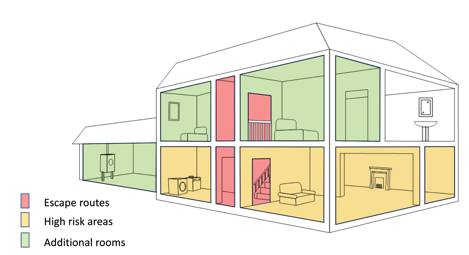It recommends that a fire alarm system should be installed in all new and existing dwellings.

Fire alarms should also be interconnected to ensure residents are alerted to the danger throughout the dwelling.
BS5839 classifies alarms by Grades and provides installation Categories
The Grade of System is the type of system to be installed, or the reliability of a system in terms of its power source and backup – Grades A to F
BS5839-6:2019 sub-divides the Grades D and F as follows: `
|
Grade |
Description |
Kidde Solution |
|
D1 |
Mains-powered alarms, each with a tamper-proof standby battery |
KF20R, KF30R CV2208, CV3202 |
|
D2 |
Mains-powered alarms, each with a ‘loose’ user-replaceable battery |
KF20, KF20LL, KF30, KF30LL |
|
F1 |
Battery-powered alarms, each with a tamper-proof standby battery |
10Y29, K2007 CV2106, CV3106 |
|
F2 |
Battery-powered alarms, each with a ‘loose’ user-replaceable battery |
29HD, DY29, 2030-DSR |
Categories
This helps to define in which areas of the dwelling the smoke or heat alarms are required.
While LD1 is recommended, a good level of protection can be achieved for most properties by following the LD2 approach.
|
Category |
Smoke Alarm Locations |
|
LD1 |
A system installed throughout the dwelling, with alarms in all circulation areas that form part of escape routes, as well as in bedrooms, kitchens and living areas (but not in bathrooms) |
|
LD2 |
A system with detectors in all circulation areas that form part of escape routes, as well as in kitchens and living areas |
|
LD3 |
A system with detectors in all circulation areas that form part of escape routes |
Categories LD1

Categories LD2

Categories LD3

How do you apply Grades and Categories?
Minimum Protection
The minimum standard recommended by the Code for most properties with no single floor over 200m2 can generally be summarized as follows:
Minimum Grade
Grade D1 – all rented properties
Grade D2 – owner-occupied, new and 4-storey or more existing properties. Or in place of Grade F2 during rewiring.
Grade F1 or F2 – owner-occupied existing properties, up to 3-storeys.
Minimum Category
For properties up to three storeys, a minimum of Category LD2 is generally recommended.
This means smoke alarms in living rooms, as well as escape routes, and also heat alarms in kitchens.
Summary
- BS5839-6:2019+A1:2020 provides the Code Of Practice for fire alarm systems
- The Grade of system is the type of system to be installed, or the reliability of a system in terms of its power source and backup – Grades A to F
- Categories help to define in which areas of the dwelling the smoke or heat alarms are required.
- While LD1 is recommended, a good level of protection can be achieved for most properties by following the LD2 approach
The ‘Code of Practice’ recommends minimum levels of Grades and Categories when deciding which alarms are required in a dwelling, are where to locate them
